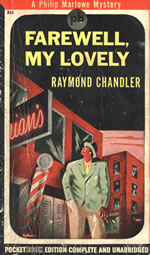Farewell, My Lovely
 Cover Artist:
Cover Artist: H. Lawrence Hoffman
By: Chandler, Raymond
Publisher: Pocket Books, Inc. (212)
Place of Publication:New York, NY
Catalog #: Kelley Box 216: PS3505 .H3224 F2 1943b
Contributor:
J. Lukin
General
Era: 1940s
Author as on Cover: Raymond Chandler
Publication:1943
Original Date: 1940
Setting: urban; wealthy suburban, ultra-wealthy offshore gambling boats
Plot Summary
Prompted by curiosity and pity, private investigator Philip Marlowe tries to help hapless ex-con Moose Malloy, who's searching for his old girlfriend. Malloy doesn't know his own strength, and tends to accidentally kill people who might provide him with leads. While Malloy is in hiding to avoid arrest for these murders, Marlowe is retained for a seemingly unrelated case requiring the recovery of a rich woman's stolen jewelry. He fails. In attempting to find the connection between the two cases, Marlowe falls into the hands of a psychopathic con artist, an evil physician, and a corrupt suburban police force. Finally, with the help of a genteel crime boss, Marlowe finds Malloy, and allows him to discover the truth about his ex-girlfriend's fate. Too late, Malloy learns that his quest was a bad idea.
Major Characters
Philip Marlowe adult male, mid-30s, tall, professional private investigator
Anne Riordan adult female, 28 years old, beautiful, auburn hair, writer and amateur detective
Randall adult male, middle-aged, smooth features, homicide detective
Moose Malloy adult male, huge proportions, loud clothes, former bank robber, now unemployed
Sergeant "Hemingway" Galbraith adult male, middle-aged, burly, a cop on the take
Jules Amthor adult male, seemingly ageless, soulless black eyes, an international con artist who poses as a psychic
Helen Grayle adult female, close to 30, wealthy society lady and seductress with a killer body and golden hair
Laird Brunette adult male, middle-aged, average in size, with a predatory smile, a gambling boss and drug dealer who owns an L.A. suburb
Lindsay Marriott adult male, 30s, handsome, blonde, sexually ambiguous, formerly a radio announcer, now an escort for women
Jessie Florian adult female, in her 50s, drunk and decrepit, a former servant living on a pension from her employer
Weapons
guns, hands, blunt instrument, blackjack
Level of Violence
three people are shot to death, two have their necks broken by a strong pair of hands, one has his brains beaten out by a blunt instrument. Marlowe repeatedly gets sapped (knocked unconscious with a blackjack) and once beats a thug with a bedspring. Presentations of violence tend to be brief but vivid.
Sexuality
the story involves a femme fatale who inspires blind loyalty in men, often to their detriment. Marlowe shuns sex, resisting Mrs. Grayle's seduction and chivalrously attempting to avoid compromising his pal Anne. Whether he eventually acquiesces to the latter's desire for him is left ambiguous.
Gender Roles
two poor, middle-aged white women are presented as stupid, disgusting, dishonest, manipulative gossips. Some disapproval of men who are supported by women is hinted at.
Ethnicity
plenty of racist language is used, some of it by Marlowe. Indeed, Marlowe is not unduly disturbed by the murder of a black man; and he regards the increasing number of African-Americans in a neighborhood as evidence of its deterioration. The sole "Jap" (Marlowe's term) to appear is a stereotypical fussy gardener; the sole Native American character is a foul-smelling thug. We also see a beautiful, plucky Irish girl and a brave Scandinavian ex-cop.
Alcohol/Drug Abuse
many characters smoke -- Marlowe alternates between cigarettes and a pipe. Lindsay Marriott uses marijuana. The evil Dr. Sonderborg imprisons Marlowe and fills him with morphine and scopolamine. Most characters drink socially; Marlowe also uses alcohol as an analgesic to relieve the pain after he's been beaten.
Law Enforcement
Los Angeles cops are depicted as intelligent, generally honest, and working with varying levels of energy and competence. They tend to recognize Marlowe as an ally; a lazy sergeant even expects Marlowe to work for him. The police force of Bay City is completely corrupt -- at best, its officers are hired thugs for the community's criminals -- but thanks to Marlowe's work, it undergoes a purge by the novel's end.
Subject Headings
Marlowe, Philip/ Corruption (In Politics)/ California - Los Angeles/ Murder/ Detectives, Private
Psychological Elements
a central character is motivated by shame over a less-than-respectable past. Marlowe often tends toward pessimism, cynicism, and disgust with the spread of corruption and the amoral exercise of power in his world, but his sense of adventure and of his own ability occasionally to give a deserving man a break prevent him from descending into total despair.
Film Adaptations
The Falcon Takes Over, 1942, RKO;
Murder My Sweet, 1945, RKO; Farewell, My Lovely, 1975, AVCO
 Cover Artist: H. Lawrence Hoffman
Cover Artist: H. Lawrence Hoffman